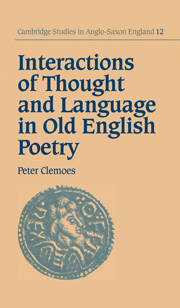Book contents
- Frontmatter
- Contents
- Illustrations
- Preface
- Abbreviations
- PART I The poetry of an aristocratic warrior society
- 1 The chronological implications of the bond between kingship in Beowulf and kingship in practice
- 2 Society's ancient conceptions of active being and narrative living
- 3 Poetry's tradition of symbolic expression
- 4 The language of symbolic expression
- 5 Types of symbolic narrative
- 6 Basic characteristics of symbolic story
- PART II The poetry of a universal religion
- Works cited
- Index I Quotations of two or more ‘lines’ of Old English poetry
- Index II A representative selection of the symbols and word pairs cited in discussion
- Index III General
5 - Types of symbolic narrative
Published online by Cambridge University Press: 18 December 2009
- Frontmatter
- Contents
- Illustrations
- Preface
- Abbreviations
- PART I The poetry of an aristocratic warrior society
- 1 The chronological implications of the bond between kingship in Beowulf and kingship in practice
- 2 Society's ancient conceptions of active being and narrative living
- 3 Poetry's tradition of symbolic expression
- 4 The language of symbolic expression
- 5 Types of symbolic narrative
- 6 Basic characteristics of symbolic story
- PART II The poetry of a universal religion
- Works cited
- Index I Quotations of two or more ‘lines’ of Old English poetry
- Index II A representative selection of the symbols and word pairs cited in discussion
- Index III General
Summary
Having surveyed vernacular poetry's binary noun-based structures as a system for implying interactions of traditionally perceived basic potentials in active being, we should now turn our attention to the types of narrative which turned these implications into explicit active living, or – to put it in terms of the processes of poetry itself – produced active symbolization by converting symbolic potential into symbolic narrative. The essential agent of this change was a narrator: a narrator as a ‘voice’, uttering a poem was a persona distinct not only from anyone (or anyone else) in the narrative which he/she/it was telling but also from the composing poet on the one hand and an audience (or readership) on the other. The ‘voice’ had an ‘identity’ which varied from poem to poem, firstly according to the relationship which he/she/it claimed to have to what was being told – a narrator might assert that he/she/it had heard what was being recounted or had witnessed it or was speaking about him/her/itself – and secondly according to whether there was an explicit addressee (and, if so, of what sort) or no addressee in particular. Different types of narrative resulted from these variables in narration.
The Beowulf narrator, for example, was defined by a ‘having heard’ relationship to his material and by an absence of any claim to be addressing anyone in particular.
- Type
- Chapter
- Information
- Interactions of Thought and Language in Old English Poetry , pp. 169 - 188Publisher: Cambridge University PressPrint publication year: 1995

